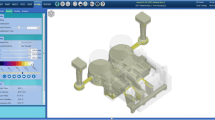Abstract
The article provides information on existing modeling program systems, their brief description and ability of practical application. A comparative analysis of the advantages and disadvantages of such simulation systems, which allowed in the framework of the tasks to reduce the number of systems under study to two were carried out. The calculation of the sprinkling system for casting from the alloy 20X5ML of the compressor wheel based on its model unit is performed, while using the LVMflow modeling program, its most effective version of such a system was found. It is designed for the yield of suitable, the materials are selected to obtain the required chemical composition of the alloy, based on the condition that the smelting will be made on return and raw materials, the costs of their acquisition are determined. Further, this calculation option was used as the original for modeling in the Procast program, which made it possible to obtain more higher prime yield with suitable costs for raw melting stock.
Access this chapter
Tax calculation will be finalised at checkout
Purchases are for personal use only
Similar content being viewed by others
References
Gorski, F., Zawadzki, P., Hamrol, A.: Knowledge based engineering as a condition of effective mass production of configurable products by design automation. J. Mach. Eng. 16(4), 5–30 (2016)
Gramegna, N., Corte, E.D., Poles, S.: Manufacturing process simulation for product design chain optimization. Mater. Manuf. Process. 26(3), 527–533 (2011)
Grzegorzewski, P., Kochanski, A.: Data and modeling in industrial manufacturing. In: Grzegorzewski, P., Kochanski, A., Kacprzyk, J. (eds.) Soft Modeling in Industrial Manufacturing. SSDC, vol. 183, pp. 3–13. Springer, Cham (2019). https://doi.org/10.1007/978-3-030-03201-2_1
Kozłowski, J., Jakimiuk, M., Rogalewicz, M., Sika, R., Hajkowski, J.: Analysis and control of high-pressure die-casting process parameters with use of data mining tools. In: Hamrol, A., Kujawińska, A., Barraza, M.F.S. (eds.) MANUFACTURING 2019. LNME, pp. 253–267. Springer, Cham (2019). https://doi.org/10.1007/978-3-030-18789-7_22
Gramegna, N.: Smart casting process control and real time quality prediction. In: 9th VDI Conference with Specialist Exhibition on Casting Technology in Engine Construction: Potential for the Next generation of Vehicle Propulsion, vol. 2304, pp. 227–234 (2017)
Sika, R., Ignaszak, Z.: Cause-effect analysis using A&DM system for casting quality prediction. Arch. Foundry Eng. 20(2), 5–12 (2020)
Patnaik, L., Saravanan, I., Kumar, S.: Die casting parameters and simulations for crankcase of automobile using MAGMAsoft. Mater. Today Proc. 22, 563–571 (2020)
Kumar, R., Madhu, S., Aravindh, K., Jayakumar, V., Bharathiraja, G., Muniappan, A.: Casting design and simulation of gating system in rotary adaptor using procast software for defect minimization. Mater. Today Proc. 22, 799–805 (2020)
Haldar, P., Sutradhar, G.: Simulation and validation of castings in shop floor. In: Casting Processes and Modelling of Metallic Materials. IntechOpen (2021)
Jones, C.A., et al.: A verification of thermophysical properties of a porous ceramic investment casting mould using commercial computational fluid dynamics software. In: IOP Conference Series: Materials Science and Engineering, vol. 861, no. 1, p. 012036 (2020)
Ogorodnikova, O.M., Yeltsin, S.V., Martynenko, S.V.: Reconstruction of thermo-physical properties to improve material database for casting simulation. In: IOP Conference Series: Materials Science and Engineering, vol. 971, no. 3, p. 032089 (2020)
Turishchev, V.V.: Modeling of foundry processes: what to choose? CADmaster 2, 33–35 (2005)
Kozlowski, J., Sika, R., Gorski, F., Ciszak, O.: Modeling of foundry processes in the era of industry 4.0. In: Design. Simulation, Manufacturing: The Innovation Exchange, pp. 62–71. Springer, Cham (2018)
Abdullin, A.D.: New capabilities of software package ProCAST 2011 for modeling foundry operations. Metallurgist 56, 323–328 (2012)
Dong, R., Feng, H., Wang, J.: Study on simulation and optimization of the casting method of mining up-tight wheel based on ProCast software. GAK gummi fasern kunststoffe 69(13), 1086–1090 (2016)
Zaloznik, M., Sarler, B.: Modeling of macrosegregation in direct-chill casting of aluminum alloys: estimating the influence of casting parameters. Mater. Sci. Eng. A 413, 85–91 (2005)
Kukartsev, V.A., Kukartsev, V.V., Tynchenko, V.S., Radionov, A.A.: Production technology of synthetic iron to ensure the efficiency of casting production. In: Materials Science Forum 989 MSF, pp. 600–605 (2020)
Kukartsev, V.A.: Cast iron and steel smelting in industrial frequency induction furnaces. Steel 5, 26–28 (2016)
Acknowledgements
This article was prepared as part of a research carried out with the financial support of the Russian science Foundation according to the research project No. 19–71-00028 within the framework of the Competition of 2019 “Conducting initiative research by young scientists”.
Author information
Authors and Affiliations
Editor information
Editors and Affiliations
Rights and permissions
Copyright information
© 2021 The Author(s), under exclusive license to Springer Nature Switzerland AG
About this paper
Cite this paper
Kukartsev, V., Kaposhko, I., Kukartsev, V., Tynchenko, V., Leonteva, A., Kartsan, I. (2021). Features of Using Programs for Casting Processes Modeling. In: Silhavy, R., Silhavy, P., Prokopova, Z. (eds) Software Engineering Application in Informatics. CoMeSySo 2021. Lecture Notes in Networks and Systems, vol 232. Springer, Cham. https://doi.org/10.1007/978-3-030-90318-3_3
Download citation
DOI: https://doi.org/10.1007/978-3-030-90318-3_3
Published:
Publisher Name: Springer, Cham
Print ISBN: 978-3-030-90317-6
Online ISBN: 978-3-030-90318-3
eBook Packages: Intelligent Technologies and RoboticsIntelligent Technologies and Robotics (R0)




